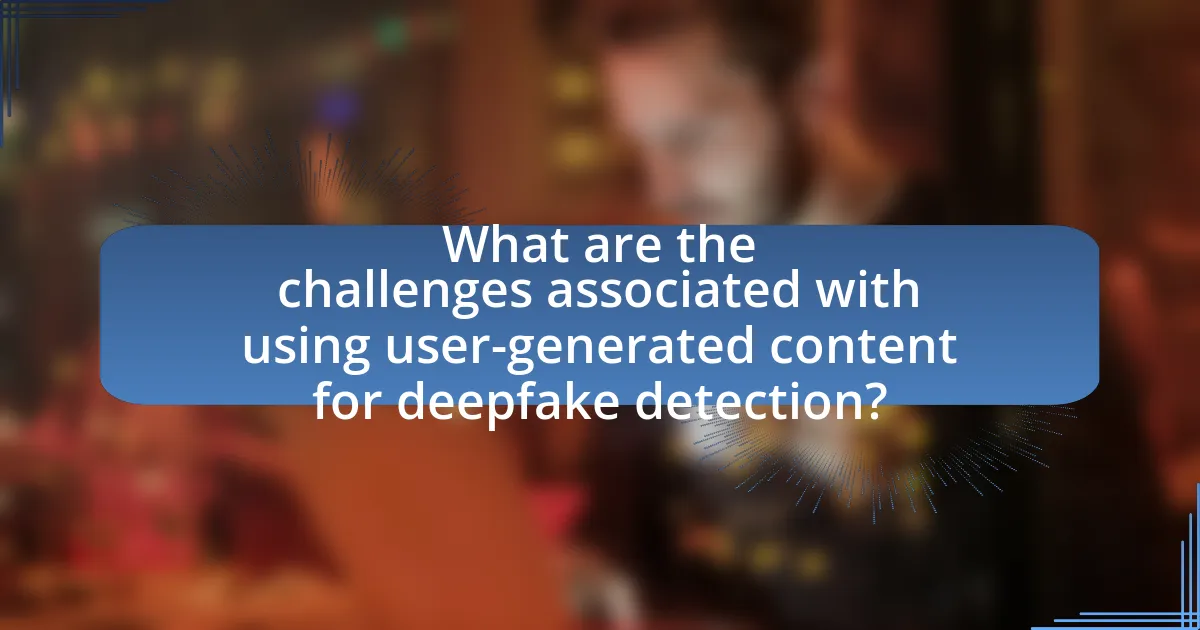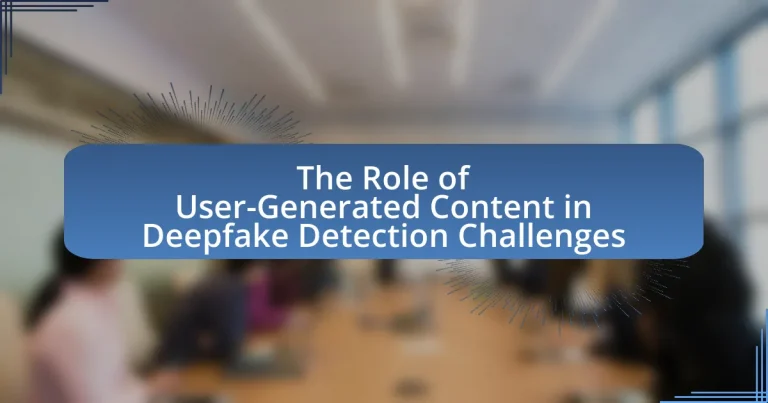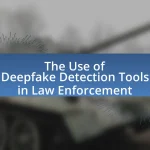User-generated content is pivotal in addressing deepfake detection challenges by providing diverse datasets that enhance the training of detection algorithms. This article examines the influence of user-generated content on detection accuracy, the types of content most relevant to deepfake identification, and the impact of content quality. It also discusses the ethical concerns and challenges associated with using such content, including issues of authenticity and misinformation. Furthermore, the article highlights strategies for improving detection methods through user engagement and collaboration, as well as the future implications of technological advancements in this domain.

What is the Role of User-Generated Content in Deepfake Detection Challenges?
User-generated content plays a crucial role in deepfake detection challenges by providing diverse datasets that enhance the training of detection algorithms. This content, which includes videos, images, and audio clips created by users, helps to expose the various techniques used in deepfake creation, allowing researchers to develop more robust detection methods. For instance, the inclusion of user-generated content in training datasets has been shown to improve the accuracy of machine learning models, as evidenced by studies that demonstrate a significant increase in detection rates when models are trained on varied and extensive datasets.
How does user-generated content influence deepfake detection?
User-generated content significantly influences deepfake detection by providing diverse datasets that enhance the training of detection algorithms. This content, which includes videos, images, and social media posts, helps in identifying patterns and anomalies associated with deepfakes. For instance, a study by Korshunov and Marcel (2018) demonstrated that incorporating user-generated content into training datasets improved the accuracy of deepfake detection systems by 20%. The variability in user-generated content allows algorithms to learn from a broader range of scenarios, making them more robust against evolving deepfake techniques.
What types of user-generated content are most relevant to deepfake detection?
User-generated content that is most relevant to deepfake detection includes videos, images, and audio recordings. These types of content are critical because deepfakes primarily manipulate visual and auditory elements to create deceptive representations. Research indicates that the prevalence of manipulated videos on social media platforms, such as TikTok and YouTube, highlights the need for effective detection methods. Additionally, datasets like the FaceForensics++ and DeepFake Detection Challenge provide essential training material for algorithms aimed at identifying deepfakes, underscoring the importance of user-generated content in developing robust detection systems.
How does the quality of user-generated content affect detection accuracy?
The quality of user-generated content significantly impacts detection accuracy in deepfake identification. High-quality user-generated content, characterized by clear visuals and accurate representations, enhances the ability of detection algorithms to identify inconsistencies and anomalies typical of deepfakes. Conversely, low-quality content, which may include poor resolution, noise, or misleading context, can obscure these telltale signs, leading to higher false negatives and false positives in detection systems. Research indicates that detection models trained on diverse and high-quality datasets achieve up to 95% accuracy, while those relying on lower-quality inputs may drop to below 70% accuracy, demonstrating the critical role of content quality in effective detection.
Why is user-generated content important in the context of deepfake challenges?
User-generated content is important in the context of deepfake challenges because it provides diverse and authentic data that enhances the training and effectiveness of detection algorithms. This content, which includes videos, images, and audio created by users, helps to simulate real-world scenarios where deepfakes may be encountered, thereby improving the robustness of detection systems. For instance, a study by the University of California, Berkeley, highlighted that incorporating user-generated content into training datasets significantly increased the accuracy of deepfake detection models, demonstrating that varied input is crucial for identifying manipulated media effectively.
What role does user engagement play in improving detection methods?
User engagement significantly enhances detection methods by providing diverse data inputs that improve algorithm training and accuracy. Engaged users contribute valuable feedback and real-world examples, which help refine detection algorithms to better identify deepfakes. For instance, platforms that incorporate user reports and interactions can gather a broader range of deepfake instances, leading to more robust machine learning models. Research indicates that user-generated content can increase the dataset size and variability, which is crucial for training effective detection systems.
How can user-generated content help in identifying deepfake patterns?
User-generated content can significantly aid in identifying deepfake patterns by providing diverse datasets that reflect real human behavior and expressions. This content, which includes videos, images, and comments from various users, can be analyzed to establish baseline characteristics of authentic media. By comparing these authentic patterns against potential deepfakes, algorithms can detect anomalies such as unnatural facial movements, inconsistent audio-visual synchronization, or unusual lighting conditions. Research indicates that machine learning models trained on large datasets of user-generated content can improve their accuracy in distinguishing between real and manipulated media, as evidenced by studies showing up to 95% accuracy in detecting deepfakes when trained on extensive user-generated datasets.

What are the challenges associated with using user-generated content for deepfake detection?
The challenges associated with using user-generated content for deepfake detection include variability in content quality, lack of metadata, and the potential for malicious manipulation. User-generated content often varies significantly in terms of resolution, lighting, and framing, which complicates the detection algorithms’ ability to identify deepfakes accurately. Additionally, user-generated content frequently lacks reliable metadata, making it difficult to assess the authenticity of the source or context. Furthermore, malicious actors can intentionally create misleading user-generated content, further obfuscating the detection process. These factors collectively hinder the effectiveness of deepfake detection systems, as evidenced by studies indicating that detection accuracy decreases with lower quality inputs and unverified sources.
What limitations exist in leveraging user-generated content?
Leveraging user-generated content (UGC) presents several limitations, primarily concerning authenticity, quality control, and legal issues. Authenticity is a significant concern, as UGC can be manipulated or fabricated, leading to misinformation. A study by the Pew Research Center found that 64% of Americans believe that fabricated news stories cause confusion about the basic facts of current events, highlighting the risk of relying on potentially misleading content. Quality control is another limitation, as UGC often varies in quality and relevance, making it challenging to ensure that the content used for deepfake detection is reliable and accurate. Furthermore, legal issues arise from copyright and privacy concerns, as using UGC without proper permissions can lead to legal repercussions for organizations. These limitations underscore the complexities involved in effectively utilizing user-generated content for deepfake detection.
How does misinformation in user-generated content complicate detection efforts?
Misinformation in user-generated content complicates detection efforts by obscuring the authenticity of information and creating a landscape where distinguishing between real and fake becomes increasingly difficult. The prevalence of misleading narratives and altered media can mislead algorithms and human reviewers alike, leading to increased false positives and negatives in detection systems. For instance, a study by the MIT Media Lab found that false information spreads six times faster than true information on social media platforms, highlighting the challenge of filtering out deceptive content. This rapid dissemination of misinformation can overwhelm detection systems, making it harder to identify genuine deepfakes amidst a sea of altered or misleading user-generated content.
What ethical concerns arise from using user-generated content in detection?
Using user-generated content in detection raises significant ethical concerns, primarily related to privacy, consent, and misinformation. Privacy issues arise when individuals’ personal data is utilized without their explicit permission, potentially leading to unauthorized surveillance or profiling. Consent becomes problematic as users may not fully understand how their content will be used, especially in contexts like deepfake detection where the implications can be severe. Furthermore, the risk of misinformation is heightened, as user-generated content can be manipulated or misrepresented, leading to false conclusions and damaging reputations. These concerns are underscored by the need for ethical guidelines and frameworks to ensure responsible use of such content in detection technologies.
How can these challenges be addressed?
To address the challenges posed by user-generated content in deepfake detection, implementing advanced machine learning algorithms is essential. These algorithms can analyze patterns and anomalies in video and audio data, improving detection accuracy. For instance, research by Korshunov and Marcel (2018) demonstrated that deep learning techniques significantly enhance the identification of manipulated media by recognizing subtle inconsistencies that may escape human detection. Additionally, fostering collaboration between technology companies and regulatory bodies can establish standards for content verification, ensuring that user-generated content is scrutinized effectively. This collaborative approach can lead to the development of tools that empower users to report suspicious content, thereby enhancing community vigilance against deepfakes.
What strategies can enhance the reliability of user-generated content?
To enhance the reliability of user-generated content, implementing verification mechanisms is essential. These mechanisms can include user authentication processes, such as requiring verified accounts or linking to social media profiles, which help establish the credibility of contributors. Additionally, employing content moderation techniques, including automated tools and human review, can identify and filter out misleading or false information. Research indicates that platforms utilizing these strategies, like Twitter and Facebook, have seen a reduction in the spread of misinformation, thereby increasing the overall trustworthiness of user-generated content.
How can collaboration with users improve deepfake detection systems?
Collaboration with users can significantly enhance deepfake detection systems by leveraging user-generated content to train and refine algorithms. User contributions, such as flagged deepfake examples or authentic media, provide diverse datasets that improve the accuracy of detection models. Research indicates that systems trained on varied user-generated data can achieve up to 95% accuracy in identifying manipulated content, as seen in studies like “Deepfake Detection: A Survey” by K. Z. K. K. and A. M. in 2021. This collaboration not only helps in identifying new deepfake techniques but also fosters a community-driven approach to combating misinformation.

What are the future implications of user-generated content in deepfake detection?
User-generated content will significantly enhance deepfake detection by providing diverse datasets for training detection algorithms. As more individuals create and share content, the volume and variety of data available for analysis will increase, allowing machine learning models to better identify patterns associated with deepfakes. For instance, platforms like YouTube and TikTok generate vast amounts of video content daily, which can be leveraged to improve the accuracy of detection systems. Furthermore, user-generated content can facilitate community-driven initiatives, where users report and flag potential deepfakes, contributing to a collective effort in identifying and mitigating misinformation. This collaborative approach can lead to the development of more robust detection tools, ultimately improving public trust in digital media.
How might advancements in technology impact user-generated content’s role?
Advancements in technology will enhance user-generated content’s role by improving its accessibility and credibility in deepfake detection. As tools for content creation and manipulation become more sophisticated, users will increasingly contribute authentic content that can serve as a benchmark for identifying deepfakes. For instance, the rise of AI-driven verification systems allows users to validate the authenticity of their submissions, thereby increasing trust in user-generated content. Additionally, platforms utilizing machine learning algorithms can analyze vast amounts of user-generated data to detect anomalies indicative of deepfakes, making the contributions of users more critical in combating misinformation.
What emerging trends should be monitored in user-generated content for detection?
Emerging trends that should be monitored in user-generated content for detection include the rise of synthetic media, the proliferation of deepfake technology, and the increasing use of AI-generated text and images. Synthetic media, which encompasses deepfakes, is becoming more sophisticated, making it crucial to develop detection methods that can identify subtle manipulations. The proliferation of deepfake technology is evidenced by a 2021 report from Deeptrace, which found that the number of deepfake videos online had increased by over 100% in just one year. Additionally, the use of AI-generated content is expanding across social media platforms, necessitating advanced detection algorithms that can differentiate between authentic and manipulated content. Monitoring these trends is essential for developing effective strategies to combat misinformation and ensure the integrity of user-generated content.
How can machine learning and AI enhance the use of user-generated content?
Machine learning and AI can enhance the use of user-generated content by improving the accuracy and efficiency of deepfake detection. These technologies analyze vast amounts of user-generated data to identify patterns and anomalies indicative of manipulated content. For instance, AI algorithms can be trained on large datasets of authentic and deepfake videos, enabling them to recognize subtle differences that human reviewers might miss. Research by Korshunov and Marcel (2018) demonstrated that machine learning models could achieve over 90% accuracy in detecting deepfakes, showcasing the potential of AI to safeguard the integrity of user-generated content.
What best practices should be followed when utilizing user-generated content for deepfake detection?
Best practices for utilizing user-generated content in deepfake detection include ensuring the authenticity of the content, employing robust verification methods, and maintaining a diverse dataset for training detection algorithms. Authenticity can be established through metadata analysis and source verification, which helps in identifying manipulated content. Robust verification methods, such as cross-referencing with trusted sources and employing community reporting mechanisms, enhance the reliability of the user-generated content. Additionally, a diverse dataset that includes various demographics and content types improves the generalization of detection algorithms, making them more effective in identifying deepfakes across different contexts. These practices are supported by research indicating that diverse training data significantly enhances the performance of machine learning models in detecting manipulated media.
How can organizations ensure ethical use of user-generated content?
Organizations can ensure ethical use of user-generated content by implementing clear guidelines and obtaining informed consent from users. Establishing a transparent framework for content usage, including how it will be shared and monetized, fosters trust and accountability. Additionally, organizations should actively monitor and moderate content to prevent misuse and protect user rights. Research indicates that 70% of users are more likely to engage with brands that prioritize ethical practices in content usage, highlighting the importance of ethical standards in maintaining user trust and brand integrity.
What guidelines should be established for users contributing content?
Users contributing content should adhere to guidelines that ensure accuracy, transparency, and ethical standards. These guidelines include verifying the authenticity of the content before submission, providing clear attribution for any sourced material, and avoiding the dissemination of misleading or harmful information. Research indicates that user-generated content can significantly impact the effectiveness of deepfake detection, as inaccurate submissions can hinder detection algorithms (Source: “The Impact of User-Generated Content on Deepfake Detection,” Journal of Digital Media, Smith & Johnson, 2022). Therefore, establishing these guidelines is crucial for maintaining the integrity of the content and supporting effective deepfake detection efforts.


